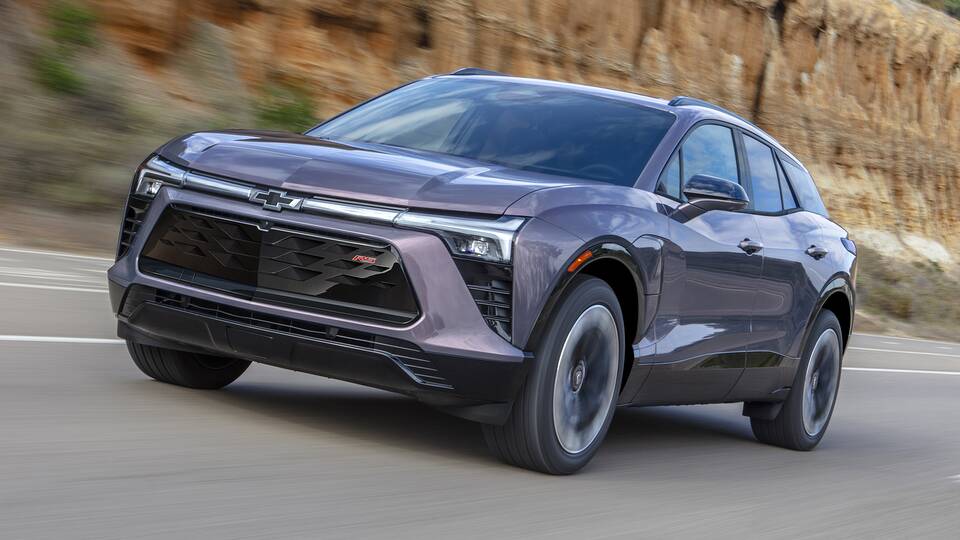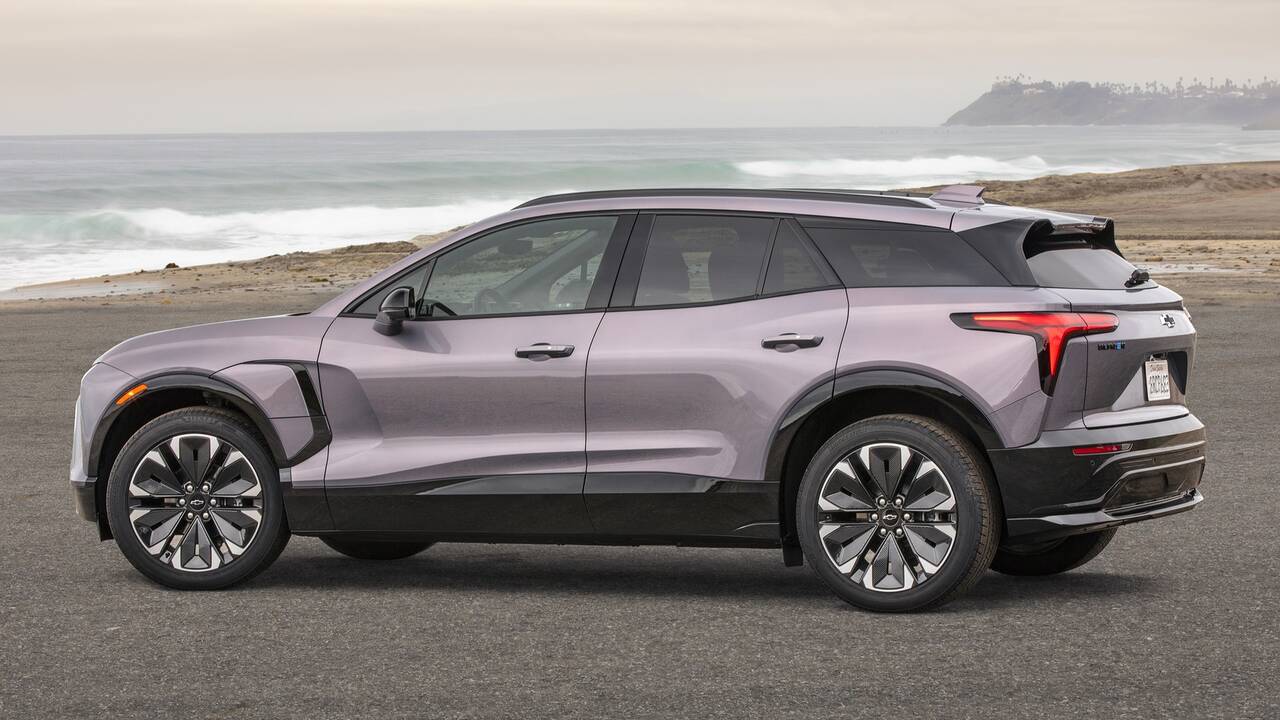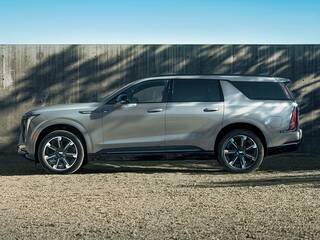The Chevy Blazer EV is about to lose the thing that made it special
The rear-wheel-drive powertrain was the best argument for upgrading from the very similar Equinox EV.

published Jun 11, 2025 | updated Jun 12, 2025

Key Takeaways
- GM sells a number of comparable electric SUVs that share platforms and powertrains.
- Chevy's Equinox EV and Blazer EV, in particular, are similar enough to make you wonder why they both exist.
- The Blazer EV's rear-wheel-drive powertrain was its clearest advantage over the Equinox EV, but that option goes away for 2026.
When the Chevrolet Blazer EV launched alongside the Chevrolet Equinox EV a couple of years ago, the similarities stood out first. They were both strictly two-row vehicles using the same GM BEV3 platform, and their lengths were within 1.6 inches of each other. So why would Chevy build both of them and charge nearly $7,000 more for the Blazer EV?
At a glance, it looked like redundancy without reason — a waste of resources that would have been more wisely invested in a single, fully optimized electric SUV aimed at the dominant Tesla Model Y.
Squinting at the spec sheet, though, a case emerged for paying the Blazer EV premium. For one thing, its entry-level equipment included the same dual-motor powertrain that was a costly option on the Equinox EV, so the apples-to-apples gap in base pricing was less than $4,000. But crucially, the Blazer EV also offered a rear-wheel-drive powertrain borrowed from the Cadillac Lyriq that delivered far more power (+52 hp) and range (+45 miles) than the dual-motor setup. Yes, it cost an extra five grand or so, but at least you could argue that it was genuinely special.
Unfortunately, that case can no longer be made as of the 2026 model year. As Car and Driver first reported and Chevy later confirmed, the rear-drive Blazer EV will be discontinued after 2025. This takes us back to redundancy without reason, I'm afraid, as far as the Blazer EV is concerned. Why buy a 2026 Blazer EV and miss saving a bundle on an Equinox EV? Unless you're talking about the 595-hp Blazer EV SS, I got nothing for ya.
Blazer EV vs. Equinox EV by the numbers
I should mention that there's one other way in which the Blazer EV departs significantly from the Equinox EV: wheelbase length. The Blazer has quite a bit more room between the wheels — 5.5 inches, to be exact. That's evidently a distinction without a difference, however, as the Blazer EV has less than one extra inch of rear legroom, which tends to be the primary benefit of a longer wheelbase. It's not like the Equinox EV was hurting in this department, by the way; the BMW X5's wheelbase is less than an inch longer.
Equinox EV vs. Blazer EV: Key Dimensions
Vehicle Wheelbase Rear Legroom Overall Length Cargo Space (Std.) Cargo Space (Max) 2025 Chevrolet Equinox EV 116.3 in 38.0 in 190.6 in 26.4 cu ft 57.2 cu ft 2025 Chevrolet Blazer EV 121.8 in 38.9 in 192.2 in 25.5 cu ft 59.1 cu ft
As you can see, the Blazer EV also fails to distinguish itself in terms of cargo space, whether standard (behind the rear seats) or max (behind the front seats, rear seatbacks folded).
So what's the point? Why go to the trouble of building both of these rigs? Well, that's where the powertrains come in.
Equinox EV vs. Blazer EV: Powertrains & Pricing
Vehicle Max Range Power Base Price 2025 Chevrolet Equinox EV FWD 319 mi 220 hp $33,600 2025 Chevrolet Equinox EV AWD 307 mi 300 hp $36,900 2025 Chevrolet Blazer EV FWD 312 mi 220 hp $44,600 2025 Chevrolet Blazer EV AWD 283 mi 300 hp $47,600 2025 Chevrolet Blazer EV RWD 334 mi 365 hp $54,200
One of these is not like the others, right? Looking at the combination of range and power, the Blazer RWD is simply in another league. Of course, that holds for pricing, too — the Cadillac Lyriq starts at $58,595 for 2025 with the exact same powertrain. That right there could explain why Chevy's dropping the Blazer RWD for 2026. Why get the Chevy, shoppers have probably been thinking, when the Caddy isn't much more expensive?
But without the RWD variant, the Blazer EV's lack of selling points vis-a-vis the Equinox EV becomes painfully apparent. I already mentioned the price gaps when these two models launched for the 2024 model year, but they've gotten bigger. Notably, the Blazer EV added a front-wheel-drive model for 2025, borrowing the Equinox EV's base FWD powertrain for that purpose. For reasons I cannot comprehend, Chevy wants an extra $11,000 for the Blazer EV FWD versus the Equinox EV FWD. Meanwhile, the 2025 Blazer EV AWD — which, again, uses the same powertrain as the Equinox EV AWD and actually gives up 24 miles of range per the EPA — carries a $10,700 premium.

Think about that for a minute. Back in the 2024 model year, when both models debuted, the Equinox EV AWD started at $45,200, while the Blazer EV AWD with the same powertrain started at $48,800. Fast forward just one year and the gap has ballooned to nearly $11,000, with a similar gap separating the front-drive versions.
The proximate cause of this outcome is the fact that the Equinox EV got a hefty price cut for 2025 and the Blazer EV didn't, but as noted, these models are fundamentally very similar under the skin. There's no merit-based justification for one costing so much more than the other.
Now, I'm not saying that the Blazer EV RWD is a slam-dunk deal by comparison, but at least it's a clear reason to consider the Blazer EV. You can have a conversation with your Chevy dealer: "I'm leaning Equinox EV because it's so much cheaper, but if I could get that rear-drive Blazer EV for a few grand less than MSRP, maybe I'd consider it," and so forth.
For 2026, though, that conversation becomes moot. Leaving aside the niche-market Blazer EV SS, you'll be offered the same two powertrains in both the Equinox EV and the Blazer EV. Unless Chevy sees fit to give the Blazer EV a big price cut of its own, it will continue to cost a lot more without offering a major advantage in any area.
MotorDonkey says
I can appreciate the dance GM's trying to do with all of these BEV3-platform siblings, a group that also includes the Cadillac Optiq, which is essentially a luxe-ified Equinox EV that uses the dual-motor powertrain. There are a lot of balls in the air here.
But the Optiq is actually a good example to end with, because I think it points the way to a more sensible Blazer EV strategy.
Consider the price gap between the Equinox EV AWD ($36,900) and the Optiq ($52,985) — that's more than $16,000 worth of separation, yet they use the same platform and powertrain. There's apparently no fear on GM's part of cannibalizing Optiq sales by offering a Chevy version at a steep discount.
So why not simply slash the price on the Blazer EV RWD and keep it around? It was clearly too close price-wise to the entry-level Lyriq, but that doesn't mean it needs to go away. GM could instead give the 2026 Blazer EV a price reduction across the board — because the current $10,000-plus premium over the Equinox EV makes no sense whatsoever — and put the RWD variant somewhere in the vicinity of $45,000.
That would make the Blazer EV RWD an intriguingly capable option right in between the Equinox EV and the Lyriq, and it would also pit it directly against the Model Y Long Range RWD ($44,990). Could Chevy win over some former Tesla fans in this climate? I wouldn't doubt it.
But perhaps just as importantly, this strategy would preserve and strengthen the best case for buying a Blazer EV in the first place. Without the RWD powertrain, the Blazer EV is little more than an Equinox EV with different styling and higher prices. That doesn't seem like a recipe for maximizing this model's success, nor for maintaining its lead over the Equinox EV in our electric SUV rankings. ⛐ md

by Josh Sadlier
Publisher and Donkey-in-Chief
Josh has been reviewing cars professionally since joining Edmunds.com fresh out of grad school in 2008. Prior to founding MotorDonkey, he spent 15 years shaping Edmunds' expert automotive content in various capacities, starting as an associate editor and ultimately serving as a senior editor before wrapping up with a five-year term as the company's first-ever director of content strategy. Josh is a card-carrying member of the Motor Press Guild and a lifelong car nut who has driven, compared and critiqued thousands of cars in his career. Helping people find their perfect car never gets old—seriously!
 Let's make it official!
Let's make it official!
Be a good donkey and we'll deliver delicious car news straight to your inbox, spam-free forever.


